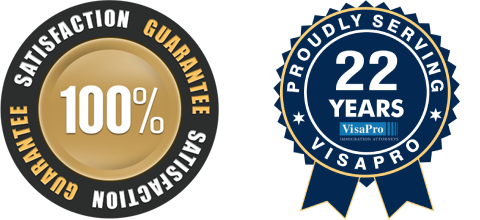Introduction
The F1 Visa Program allows bright students from around the world the opportunity to come and study in the U.S., thereby not only enriching them academically but exposing them to American culture and values.
A common question for many F1 student visa holders is regarding their employment options both during and after their education. Here we provide an overview of the numerous F1 employment options that enables a F1 student visa holder to work in the USA.
Working In The U.S. On An F1 Visa
Working in the U.S. on an F1 student visa is not permitted unless specifically authorized by the educational institution, Immigration & Customs Enforcement (ICE) or U.S. Citizenship & Immigration Services (USCIS). An F1 student who wants to work in the USA, however, have several employment options at their disposal.
A. F1 Employment On-Campus
F1 student visa holders are permitted to work on-campus for up to 20 hours per week during the semester/quarter, as soon as they start school. An F1 student may work in the USA full-time (40 hrs/week) during breaks between semesters/quarters or during the annual vacation.
F1 employment on-campus can include:
- Most types of on-campus employment where the university or college is the employer, e.g. the school library, computer lab, registrar/bursar’s office, departmental offices, or as a research assistant, or teaching assistant, etc.
- Employment with an outside organization that provides services directly to students taking place at the university, e.g. working at a bookstore on campus that primarily services university students and staff, even if the bookstore is not owned or operated directly by the university.
- Employment off-campus if the location is affiliated with the university. It is strongly recommended that students check with the international student advisor before commencing such F1 employment.
NOTE: The F1 student’s I-20 alone constitutes proof of employment authorization. Letters from the international student advisor and employer may be required in order to obtain a Social Security Number from the SSA.

B. F1 Employment Under Curricular Practical Training
Curricular Practical Training or “CPT” is practical training or work experience that is deemed “integral” to a F1 student’s major or coursework. It can include internships, cooperative work programs or actual employment with a private organization. Generally, the work experience must be required by the course or major or the student will receive academic credit for the work.
CPT can be full-time or part-time. However, if an F1 student works full-time for 12 months or more on CPT, the student will no longer be eligible for Optional Practical Training (OPT).
1. Curricular Practical Training – Who Qualifies?
In order to be eligible to work under F1 CPT:
a.The student must be in valid F1 status and currently enrolled
b.For undergraduates, the F1 student must have completed at least 1 academic year (usually 2 semesters or 3 quarters)
c.For graduate study, students may be able to work on CTP as of the first day if the degree program requires the work experience.
IMPORTANT
Each academic institution has its own criteria for administering CPT. However, the regulations generally define the CPT to be “a part of the established curriculum.” If the student files for change of status to H1B, for example, the student should be prepared to show that the employment during CPT was in fact integral to the degree program.
My Case Scenario
Joe
Joe is an Australian national who is in the U.S. on an F1 visa. He is currently a Junior in college and is pursuing a bachelor’s degree in Finance. He has been offered a great internship opportunity with a private equity firm. Can he work for them?
Unless Joe’s degree program or coursework requires that he obtain outside work experience, he will not be able to partake in the internship unless he opts to utilize pre-completion OPT (see below). An internship, even if it’s unpaid, constitutes “work” and any off-campus work by an F1 student must be authorized by the school, ICE and/or USCIS.
C. F1 Employment Under Optional Practical Training
Optional Practical Training or “OPT” allows students to gain real-world experience that is related to their fields of study. It can include full-time or part-time positions and an individual can even be self-employed while on OPT. The F1 OPT cannot last more than 12 months and at no time can an F1 student work less than 20 hours/week.
1. F1 OPT – Who Qualifies?
In order to be eligible to work in the USA under F1 OPT:
a.The student must be in valid F1 status;
b.The student must have completed at least 1 academic year (2 semesters or 3 quarters) by the time the F1 OPT starts;
c.The student must not have participated in OPT at the same degree level before.
DID YOU KNOW?
In order to obtain OPT, the international student advisor must approve the request for OPT and provide the student with an I-20 that shows that OPT has been recommended. The student must then apply for an Employment Authorization Document (Form I-765) with U.S. Citizenship & Immigration Services.
2. Post-Completion OPT vs. Pre-Completion OPT
F1 OPT can be obtained during or after the academic program is complete or a combination of both.
| Pre-completion OPT | Post-completion OPT |
|---|---|
| F1 Students are allowed to apply for OPT in order to work while enrolled in the degree program. | Post-completion OPT is the more popular path for most F1 students. Work authorization will only begin once the student has completed all degree requirements or has completed the academic program. |
| The student must work part-time while enrolled during the semester/quarter. The student can request full-time OPT or part-time OPT during their annual break. | Students can request up to 12 months of post-completion OPT as long as the student did not obtain pre-completion OPT or work full-time for 12 months or more on CPT. |
| It Is important to remember that pre-completion OPT will be deducted from any requested post-completion OPT. | It is important to note that the F1 OPT application must be submitted no more than 90 days before the program end date and no more than 60 days after the program end date. |
3. F1 Employment Under OPT – Things To Remember
There are several things to remember for students who are working on F1 OPT:
a.Once an F1 student obtains OPT, the student must work no less than 20 hours a week.
b.Students on OPT cannot accrue more than 90 days of unemployment.
c.An F1 student who applies for OPT cannot begin working until the EAD card is issued by USCIS.
d.Any employment must be related to the field of academic study.
e.Employment may be unpaid but the F1 student must be able to document that he or she worked.
DID YOU KNOW?
Under the H1B Cap Gap provisions, if an F1 student is in a period of authorized post-completion OPT when an H1B Cap petition is filed (with a start date of October 1), then the student may continue working on OPT status until September 30, even if the OPT expires before that date.
D. F1 Employment Under STEM OPT Extension
Students who are currently in their OPT period are eligible to receive a 24-month extension of their OPT if they graduated with a STEM degree (Science, Technology, Engineering or Mathematics) and if their employer is enrolled in E-Verify.
1. STEM OPT Extension – Who Qualifies?
In order to be eligible to secure a STEM OPT extension:
a.The student must be in valid F1 status and currently working on OPT.
b.The student must have graduated with a STEM degree in the U.S.
c.The F1 student must have a job offer that meets certain minimum requirements:
i.The employer must be enrolled in E-Verify;
ii.The employment must be at least 20 hours a week and cannot involve self-employment;
iii.The offered position must be in a position directly related to the degree program and involves a formal training program.
DID YOU KNOW?
Students working on OPT can request a STEM OPT extension based on a previously granted degree.For example: Anne obtains a Bachelor’s degree in Biomedical Engineering. She works for one year on F1 OPT and she is eligible for a STEM OPT extension. However, she decides she wants to go back to school and earn an MBA. Upon graduation, she receives one more year of OPT as her previous grant of OPT was at a lower degree level. When her current OPT expires, she will be eligible for a STEM OPT extension based on her undergraduate Biomedical Engineering Degree as she did not utilize it earlier.
2. Utilizing STEM OPT Extension – Things To Remember
There are several things to remember for students who are working on STEM OPT or plan to apply for STEM OPT extension:
a.Students on STEM OPT cannot accrue more than 150 days of unemployment.
b.STEM OPT application must be filed before the OPT period ends (i.e. USCIS must RECEIVE the application no later than the OPT expiration date).
c.The application can be filed up 120 days in advance of the OPT expiration date.
d.The employment must be related to the field of academic study.
e.Employment cannot be unpaid or involve self-employment.
IMPORTANT
In order to obtain the STEM OPT Extension, the international student advisor must approve the request for the STEM extension and provide the student with an I-20 that shows that STEM OPT has been recommended. The student must then apply for a new Employment Authorization Document (Form I-765) with U.S. Citizenship & Immigration Services along with the Form I-983, Training Plan for STEM OPT Students, which is filled out by the employer.
E. F1 Employment Authorization Due To Severe Economic Hardship
In order to obtain an F1 Visa at the U.S. Consulate or obtain F1 status, a prospective student must be able to show that he or she will be able to pay tuition, room & board, and otherwise afford to live in the U.S. What happens if circumstances arise after entry that change the student’s financial circumstances?
F1 Students who face “severe economic hardship” which was unforeseen or unexpected and/or beyond their control, can apply for work authorization to work off-campus. The most common scenarios include:
1.Losing financial aid or an on-campus job (as long as it was not the student’s fault);
2.Unexpected increases in tuition costs;
3.Large, unexpected expenses, like medical bills; or
4.Unexpected hardship or changes to the financial condition of the student’s financial sponsor (usually parents or other relative).
IMPORTANT
Students intending to apply for permission to apply for work authorization due to Severe Economic Hardship should keep a few important things in mind:1.The international student advisor must approve the request for work authorization.
2.The student must apply for an EAD card in order to work.
3.The F1 student must be able to show that he or she was unable to obtain an on-campus job or that the pay for an on-campus job is too low.
4.The F1 student must have been enrolled for at least one academic year (2 semesters or 3 quarters) and must be in good standing.
5.The EAD is renewable in 1 year increments but the student must be able to show that the financial hardship continues to exist. This time will not count against post-completion OPT.
6.The employment authorization will cease when the student graduates, transfers or does not maintain F1 status.
F. F1 Employment As An International Organization Intern
An F1 student is allowed to intern with certain designated international under the “International Organization Immunities Act.”
In order to be eligible to be employed as an international organization intern:
1.The F1 student must have an offer letter from an organization on the list of approved organizations.
2.The student must be enrolled full-time.
There is no need to establish any hardships or even show that the internship is related to the academic program.
In order to obtain employment authorization, the international student advisor must approve the request and provide the F1 student with an I-20 that shows that work authorization has been recommended. The student must then apply for an Employment Authorization Document (Form I-765) with U.S. Citizenship & Immigration Services.
IMPORTANT
Border/commuter students are not permitted to participate under the International Organization Intern program.
Conclusion
U.S. academic institutions continue to attract the best and brightest students from around the world. According to recently released data from the Institute of International Education, over 1,000,000 international students studied in the U.S. during the 2016/2017 academic year.
While restrictions on ability to work in the USA for F1 visa holders often sets them apart from their peers and can be both academically and financially burdensome, there are several F1 employment options that allow F1 student visa holders to work in the USA while lawfully maintaining their F1 status.
If you have any questions regarding working in the U.S. while on F1 status, or need help in determining your eligibility for U.S. work visa options, contact our top immigration attorneys immediately for a FREE Immigration Consultation.
What VisaPro Customers Are Saying
Our applicant did indeed pass her [J-1] visa interview. She will be arriving in America later this month. DisplayCraft appreciates everything that Visa Pro have done for us. We are extremely satisfied will your efforts and I am confident that DisplayCraft will come back to Visa Pro in the future should we need to obtain a visa for another foreign employee."

 Brent Wingfield, DisplayCraft, Inc
Brent Wingfield, DisplayCraft, Inc